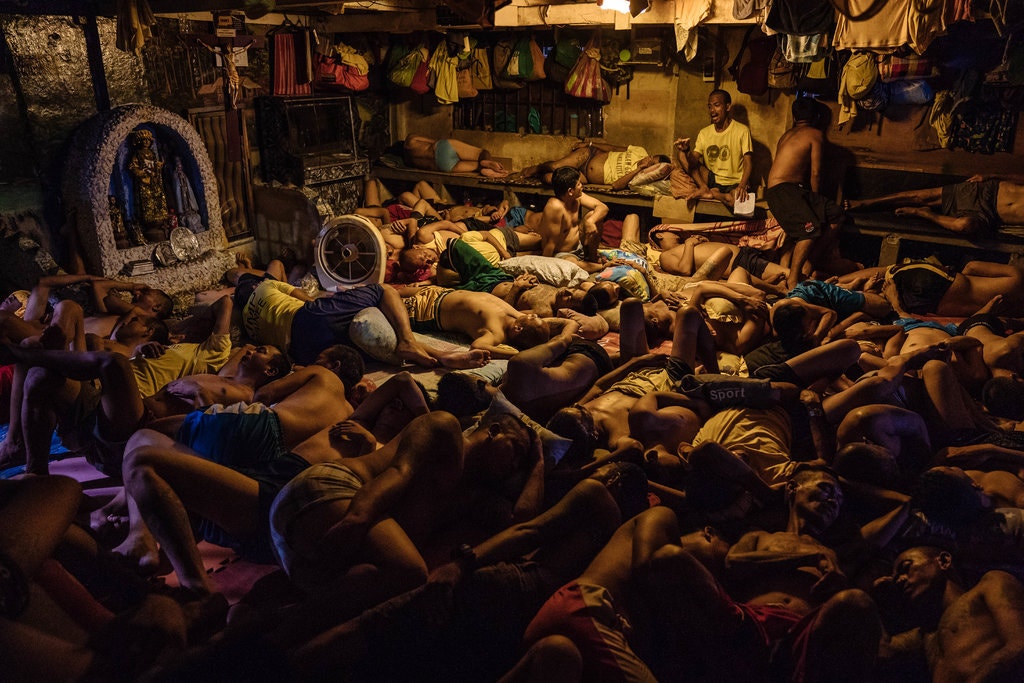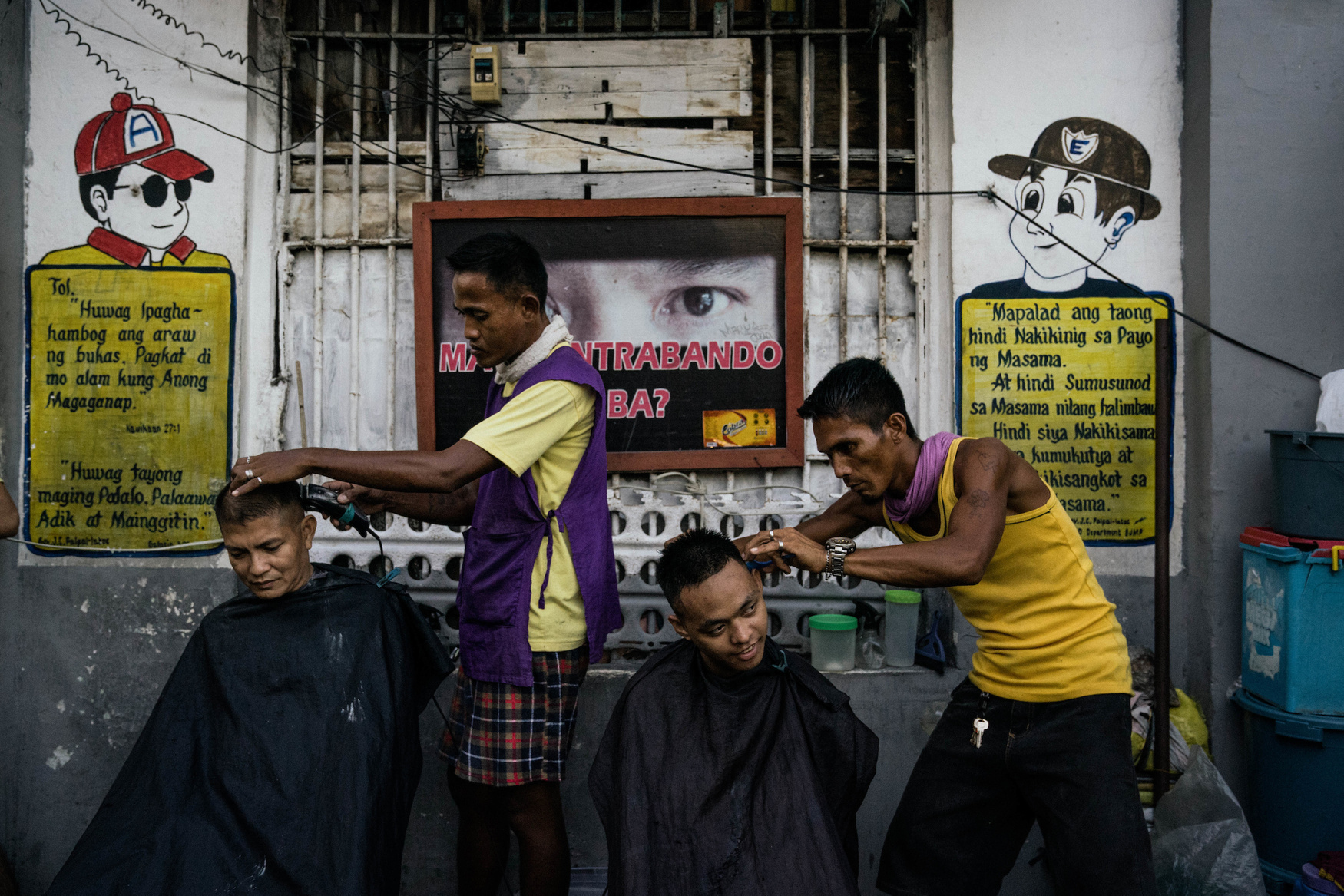Resting Inmates

A highly claustrophobic picture, that bluntly wants its viewer to feel as trapped inside as the inmates themselves. The lines of the image are irregular and do not point to any clear focus or exit point. The viewers eyes are drawn to the upper-most third of the image, but only due to the warm yellow light eminating from there. A warm yellow light that contrasts itself amongst a darker and more decaying setting. A setting that is largely unseen due to the mass of bodies that lay in front of it. These bodies are another focal point, especially how well Morales is able to capture the texture of their skin. This envokes a sense of something more organic, something more tangible and human. Something closer to home. However this humanity, is overcrowded, and trapped inside of this concrete prison. A humanity that is also seen in the focal points of the photo, which are created by lights. Firstly, the focal point at the top most third of the photo, two prisoners sharing a friendly conversation amongst their sleeping roommates. Secondly, the focal point at the left most third of the photo, created by a cooler light source. The shrine and crucifix, symbols of religion, something profoundly human. However, as is seen in the use of space, this humanity is overcrowded, and kept inside this concrete prison. It's a very blunt image that wants to convey overall, that it is not monsters trapped inside this jail, but people. They are Persons Deprived of Liberty.
Sitting Crowd

The more visible background, and the dotted arrangement of the sitting crowd is an exploration in a more extreme contrast. The lines of the image are largely irrelevant, they point to a pathway that splits the crowd, but we do not see who walks along this pathway. Instead, the prisoners act more like dots against a background rather than lines. Which is why color, and texture become incredibly important. The background is dark, cool, drab, and made of rough irritating concrete. However, the subjects of the image, are made with brighter, more saturated warm colors. The brown skintones, and the yellow (and sometimes off-white) shirts. This contrast is the crux of the image and the story it wants to tell. These inmates are humans against their cold worlds. It is the organic humanity vs the inorganic cruelty of the prison system. It is real people vs the abstract systems of justice we place them under. These prisoners are what the BJMP refers to as: Persons Deprived of Liberty.
Empty Pool Table

This photo takes on a more slice-of-life approach to depicting the humanity of the incarcerated. Yet again, similar to the images above, the photo displays a conflict between cold and warm, inorganic vs organic, concrete vs skin, and prisons vs humans. However, in this photo, the conflict takes a backseat, as the cold concrete barely in view. This photo instead chooses to focus on the prevailing humaity. This is seen most in the composition of the image. Morales chose to be closer to the subject in this image, but despite the intimacy, the picture still leaves room to breathe. This intimacy allows the viewer to see the subjects more clearly, to see the expressions on their faces as they have fun around the pool table. The viewer can see the cracks in the inmates skin, and the laugh lines and wrinkles that show the long lives they have lived. Another important aspect of this image is how for once, in the background, humanity is also depicted via the pre-established color motifs. In the buildings that make up the background of the image, people and yellow shirts can be seen. Yet again, the contrast is evident. Rough inorganic metal cool colored buildings, smooth organic warmer colored shirts and human beings. Despite this image's choice to be more intimate than others, it also captures a bigger picture. A portrait of break-time in prisons. How the inmates choose to spend this time with one another. It portrays some of the sparse moments of relief in the lives of Persons Deprived of Liberty.
Haircuts

This is the second of two images that take a slice-of-life approach to depictng the humanity of inmates. Not much can be said that hasn't already about the motifs of prisons vs humans. However, this image makes use of lines to draw attention to a concept that has not yet been explored but is integral to the idea of Trauma and Healing. That is, the backs leaned forward and out stretched arms of the barbers act as leading lines to the main focus of the image; the heads of the prisoners recieving a haircut. This symbolizes an important concept in Trauma and Healing: change. Especially in the context of the prison system, the concept of change as it is explored through haircuts is especially profound. Haircuts are a very mundane, regular bit of change that most humans living today experience in their lives. This everyday nature of haircuts as an analogy and symbol of change means to convey that change too is something that happens everyday. People are constantly shifting entities that may completely switch their morals, goals, ideas, and personalities at the drop of a hat. It calls into question the punishment of incarceration, whether or not it is really necessary or even effective at changing inmates into functioning members of society. It calls into question, whether there should be Persons Deprived of Liberty.
Behind Barbed Wire

This piece features an image depicting in-mates gathered in a large group from behind an unfocused line of barbed wire. The wires in the foreground act as leading lines toward the subjects, who reside in the lower portion of the frame. There are wires that follow the interior of the compound, leading to where there seems to be more inmates present; these said wires lead the viewers eyes to that portion of the frame. Morales is able to utilize just color in order to convey a trapped, or claustrophobic feeling in this artwork. Once again, the in-mates are characterized and highlighted by their skin tones, and the bright yellow of their uniforms. This is contrasted with the neutral colors of the prison walls, the blues of the corrugated roofs, and even the city skyline and sky above them. The juxtaposition between geometric and organic shapes further push this idea of the city, or prison swallowing the inmates. The unfocused barbed wire that sits invasively at the foreground creates geometric shapes that contrast the organic ones formed by the large group of inmates. Texture is utilized in a similar way to color in this photograph, that is, that the smooth skin and fabric textures that envelop the inmates are juxtaposed to the jagged metal of the barbed wire, the ductile corrugated construction of the metal roofs, and the rough concrete of the other buildings that surround them. If we continue to expound upon this idea, the juxtaposition between geometric and organic shapes further push this idea of the city, or prison swallowing the inmates. The inhuman structure vs the Persons Deprived of Liberty.





